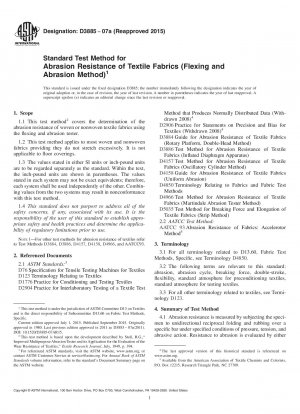ASTM D3885-07a(2015)
Standard Test Method for Abrasion Resistance of Textile Fabrics (Flexing and Abrasion Method)
- Standard No.
- ASTM D3885-07a(2015)
- Release Date
- 2007
- Published By
- American Society for Testing and Materials (ASTM)
- Status
- Replace By
- ASTM D3885-07a(2019)
- Latest
- ASTM D3885-07a(2019)
- Scope
5.1 This test method is not recommended for acceptance testing of commercial shipments because information on between-laboratory precision is known to be poor.
5.1.1 If there are differences of practical significance between reported test results for two laboratories (or more), comparative tests should be performed to determine if there is a statistical bias between them, using competent statistical assistance. As a minimum, the test samples to be used are as homogenous as possible, are drawn from the material from which the disparate test results were obtained, and are randomly assigned in equal numbers to each laboratory for testing. Other fabrics with established test values may be used for this purpose. The test results from the two laboratories should be compared using a statistical test for unpaired data, at a probability level chosen prior to the testing series. If a bias is found, either its cause must be found and corrected, or future test results must be adjusted in consideration of the known bias.
5.2 The measurement of the resistance to abrasion of textile fabrics is very complex. The resistance to abrasion is affected by many factors that include the inherent mechanical properties of the fibers; the dimensions of the fibers; the structure of the yarns; the construction of the fabrics; the type, kind, and amount of treatment added to the fibers, yarns, or fabric; the nature of the abradant; the variable action of the abradant over the specimen area abraded; the tension on the specimen; the pressure between the specimen and the abradant; and the dimensional changes in the specimen.
5.3 The measurement of the relative amount of abrasion can be affected by the method of evaluation and is often influenced by the judgment of the operator. It is recognized that with this test method other means of evaluation besides cycles to rupture and breaking strength have been used by the industry, such as color change, appearance change, and so forth. Experience has shown these to be highly variable parameters and they are not recommended without exact criteria identified in an applicable material specification or contract. Consequently, the criteria of breaking strength and cycles to rupture are the recommended means of evaluation because they are considered the least variable and interlaboratory agreement is likely to be obtained more easily.
5.4 Abrasion tests are subject to variations due to changes in the abradant bar during specific tests. The abradant bar is considered a permanent abradant that uses a hardened metal surface. It is assumed that the abradant will not change appreciably in a specific series of tests, but obviously similar abradants used in different laboratories will not likely change at the same rate due to differences in usage. Permanent abradants may also change due to pickup of treatments or other material from test fabrics and must accordingly be cleaned at frequent intervals. Consequently, depending upon its usage, the abradant bar must be checked periodically against a standard.
5.5 The resistance of textile materials to abrasion as measured by this test method does not include all the factors which account for wear performance or durability in actual use. While the abrasion resistance stated in terms of the number of cycles and durability (defined as the ability to withstand deterioration or......
ASTM D3885-07a(2015) Referenced Document
- ASTM D123 Standard Terminology Relating to Textiles
- ASTM D1776 Standard Practice for Conditioning and Testing Textiles
- ASTM D2904 Standard Practice for Interlaboratory Testing of a Textile Test Method that Produces Normally Distributed Data
- ASTM D2906 Standard Practice for Statements on Precision and Bias for Textiles
- ASTM D3884 Standard Guide for Abrasion Resistance of Textile Fabrics (Rotary Platform, Double-Head Method)
- ASTM D3886 Standard Test Method for Abrasion Resistance of Textile Fabrics (Inflated Diaphragm Apparatus)
- ASTM D4157 Standard Test Method for Abrasion Resistance of Textile Fabrics (Oscillatory Cylinder Method)
- ASTM D4158 Standard Guide for Abrasion Resistance of Textile Fabrics (Uniform Abrasion)
- ASTM D4850 Standard Terminology Relating to Fabrics and Fabric Test Methods
- ASTM D4966 Standard Test Method for Abrasion Resistance of Textile Fabrics (Martindale Abrasion Tester Method)
- ASTM D5035 Standard Test Method for Breaking Force and Elongation of Textile Fabrics (Strip Method)
- ASTM D76 Standard Specification for Tensile Testing Machines for Textiles
ASTM D3885-07a(2015) history
- 2019 ASTM D3885-07a(2019) Standard Test Method for Abrasion Resistance of Textile Fabrics (Flexing and Abrasion Method)
- 2007 ASTM D3885-07a(2015) Standard Test Method for Abrasion Resistance of Textile Fabrics (Flexing and Abrasion Method)
- 2007 ASTM D3885-07a(2011) Standard Test Method for Abrasion Resistance of Textile Fabrics (Flexing and Abrasion Method)
- 2007 ASTM D3885-07a Standard Test Method for Abrasion Resistance of Textile Fabrics (Flexing and Abrasion Method)
- 2019 ASTM D3885-07A(2019)e1 Standard Test Method for Abrasion Resistance of Textile Fabrics (Flexing and Abrasion Method)
- 2007 ASTM D3885-07 Standard Test Method for Abrasion Resistance of Textile Fabrics (Flexing and Abrasion Method)
- 2004 ASTM D3885-04 Standard Test Method for Abrasion Resistance of Textile Fabrics (Flexing and Abrasion Method)
- 2002 ASTM D3885-02 Standard Test Method for Abrasion Resistance of Textile Fabrics (Flexing and Abrasion Method)
- 1999 ASTM D3885-99 Standard Test Method for Abrasion Resistance of Textile Fabrics (Flexing and Abrasion Method)

Copyright ©2024 All Rights Reserved